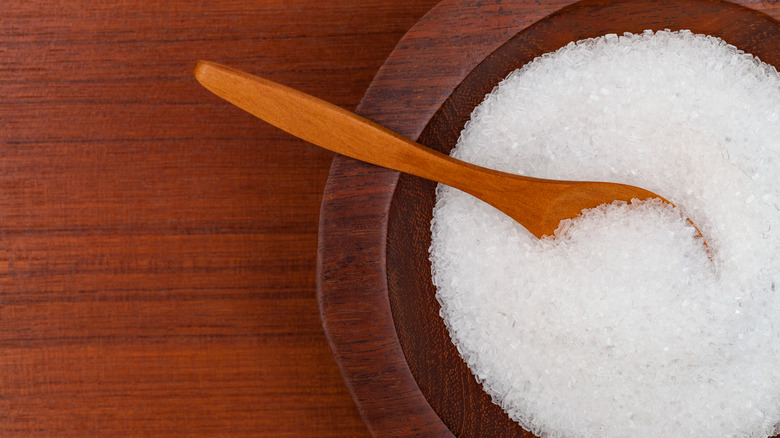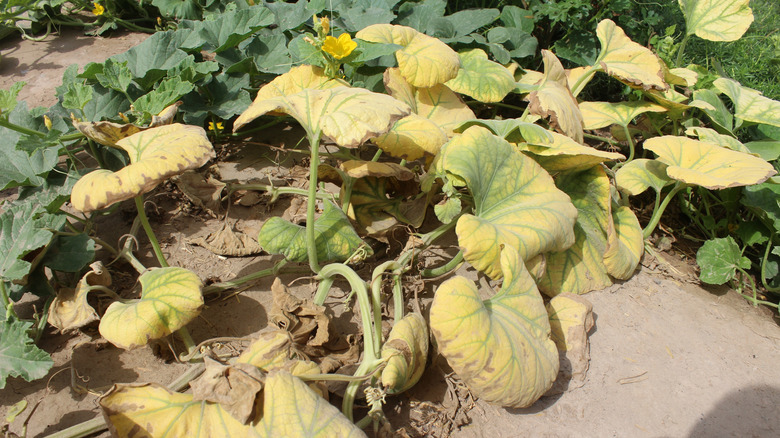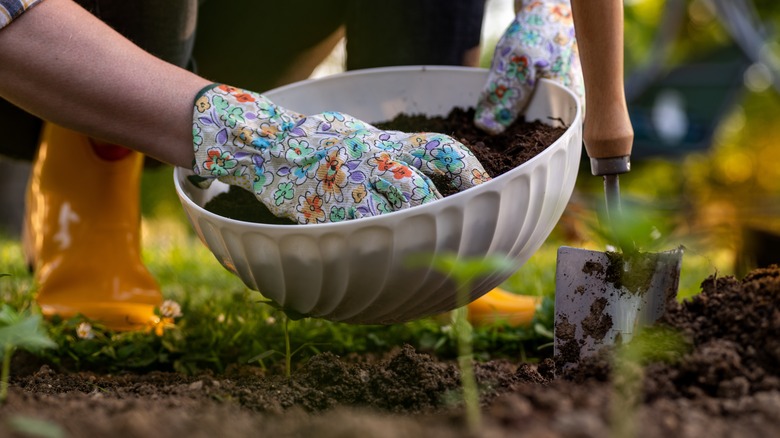Is Epsom Salt The Cure For Your Plant's Magnesium Deficiency? Here's What The Science Says
If you're seeing signs of magnesium deficiency on your plants, like older leaves turning yellow while new growth still looks healthy, you might be tempted to reach for the Epsom salt. The common household staple is frequently toted as a cure for magnesium-deficient plants. There is some basis to those claims. To understand why it works — but why it also shouldn't be your go-to fix — it helps to understand what Epsom salt is and what it does for your garden.
Despite the name, Epsom salt isn't like the salt we're used to seasoning our food with. It's a chemical compound made up of magnesium, sulfur, and oxygen. It's a highly soluble form, which means it's easy for roots to absorb, but also easily washes away with watering or rain. However, it's more of a quick fix than a long-term cure, and relying on it too heavily can create new problems for your plants. To start, there are plants that don't need Epsom salt and adding it when it's not needed can end up doing more harm than good. That's especially true if you haven't gotten a soil test to confirm a magnesium deficiency.
Even if you have confirmed that magnesium is the problem, Epsom salt won't fix the underlying issues in your garden that are causing your plants to become magnesium deficient. Instead of applying this ingredient regularly, it's better to identify the root of the problem and solve that. Keep reading to learn more about why Epsom salt isn't always the best choice and what to do instead.
Why you shouldn't rely on Epsom salt as a long-term solution
Because of its reputation as a sort of cure-all, some gardeners swear by using Epsom salt as a regular treatment, applying it as often as every two weeks. This is a bad idea. Magnesium can interfere with your plant's ability to take up potassium and calcium. Adding Epsom salt regularly, especially when there's no evidence of magnesium deficiency, can put your plant at risk of developing a potassium or calcium deficiency.
Similarly, reaching for Epsom salt when you haven't done a soil test to confirm that magnesium is, indeed, the missing ingredient can backfire. The visible symptoms of many nutrient deficiencies can look similar. If you assume those yellowing leaves are a sign that magnesium is lacking, but they're actually the result of a potassium deficiency, Epsom salt not only won't solve the problem, it'll make it worse by making it harder for your plant to get the potassium it needs.
If you have confirmed a magnesium deficiency, a small amount of Epsom salt (about one tablespoon per plant) as a side dressing can help replenish that nutrient quickly. But it still won't solve the underlying problem. A nutrient deficiency points to a problem with your soil, either the soil itself lacks nutrients, the nutrients that are there are inaccessible, or they're leaching out faster than your plant can absorb them. Epsom salt can't fix your soil. All it can do is serve as a kind of life support while you work on identifying and correcting the real problem.
How to Cure a Magnesium Deficiency for Good
Since the regular use of Epsom salt is not recommended, it's important to figure out why your plant isn't getting enough magnesium. To start, look at your soil. Sandy soils that drain too quickly are prone to leaching nutrients like magnesium before your plant's roots can absorb what they need. If the soil is too sandy, topdress with compost around your plants just before watering so you can water it in. Next year, apply a 3 or 4-inch layer of compost to your beds and till it in before planting.
If sandiness isn't the issue, over-use might be. The soil might have been depleted of nutrients in the last growing season if you planted veggies in the same area last year. Again, the long-term fix here is to apply fresh compost to that bed at the start of every growing season. You should also start rotating your vegetable garden crops to avoid planting members of the same family in the same area twice in a row.
Finally, check your fertilizer and watering routine. There may be plenty of magnesium in your soil, but you're using a high-potassium or ammonium nitrate fertilizer that's making that magnesium unavailable to your plants. In this case, stop fertilizing or switch to a slow-release organic fertilizer that has a more balanced nutrient ratio. You might also simply be watering too much, causing nutrients to leach from the soil similar to the way fast-draining soil will. If that's a possibility, switch to watering plants deeply and infrequently.


